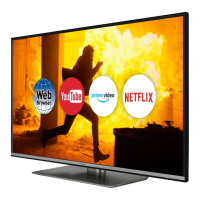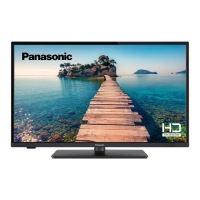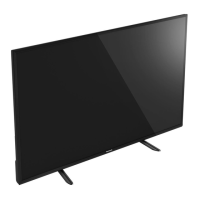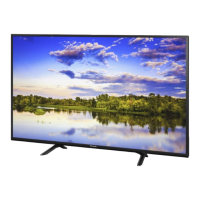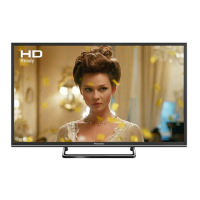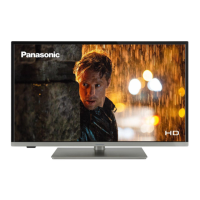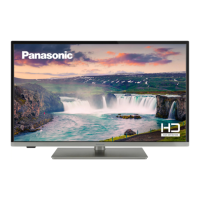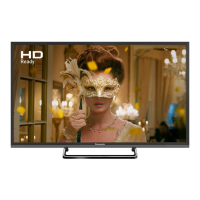Do you have a question about the Panasonic TX-32G302B and is the answer not in the manual?
Explains various symbols on the product related to safety instructions and precautions.
Details risks associated with batteries and the importance of stable TV placement.
Provides crucial warnings and instructions for safe wall-hanging bracket installation.
Instructions for cleaning the display panel, cabinet, pedestal, and mains plug.
Step-by-step guide for attaching and detaching the TV pedestal.
Instructions for safely detaching the TV pedestal for wall mounting or repacking.
Guidance on purchasing and properly installing a wall-hanging bracket.
Tips for reducing energy consumption and eco-friendly usage of the TV.
Lists the main functionalities and connectivity options of the television.
Information on automatic standby mode activation due to no signal or inactivity.
Details on using the physical control switch for volume, channel, source, and power.
Guide to using the remote control for navigating menus and controlling TV functions.
Instructions on how to switch between different input sources connected to the TV.
Customizing and navigating the main Home menu for quick access to options.
Accessing electronic program guide, channel list management, and setting timers.
Managing various TV settings including language, parental controls, and system options.
Editing names and enabling/disabling selected input source options.
Instructions for inserting AA batteries into the remote control.
Guidance on connecting the TV to the mains power supply.
Instructions for connecting the aerial or cable TV plug to the TV.
Details on HDMI and Dolby Laboratories licensing and trademarks.
Guidelines for environmentally responsible disposal of electronics and batteries.
Statement of compliance with EU directives for the TV.
Contact details for customer support and accessory ordering.
Technical details including broadcasting, audio, dimensions, and operating conditions.
Information on DVB standards compliance and potential service limitations.
Detailed explanation of each button on the remote control and its function.
Illustrations and descriptions of various input/output connectors like VGA, HDMI, SCART, USB, CI.
Instructions for powering the TV on from standby and switching it off.
Step-by-step process for initial TV setup, including language, country, and channel search.
How to connect and play media files from USB storage devices.
Navigating and playing media files (music, video, photos) from a USB device.
Controlling CEC-enabled devices connected via HDMI using the TV remote.
Using an external amplifier or receiver with the TV for audio output.
Adjusting picture modes, contrast, brightness, sharpness, colour, and advanced settings.
Adjusting volume, equalizer, balance, sound modes, and headphone output.
Configuring wired network connection and testing internet speed.
Automated and manual channel scanning, analogue tuning, and service list management.
Managing language, parental controls, date/time, accessibility, and software upgrades.
Managing, filtering, and organizing stored channels and favourite lists.
Setting up parental locks for programmes, channels, and menus.
Browsing TV schedules, event details, and filtering by genre.
Accessing and viewing digital and MHEG teletext information.
Guide to searching for and installing TV firmware updates.
Solutions for problems like TV not turning on, poor picture, or no sound.
Table illustrating typical display modes and resolutions supported for PC input.
Compatibility table for various AV and HDMI signals and resolutions.
List of video, audio, picture, and subtitle file formats supported via USB.
Table showing resolutions supported when connecting via DVI converter cable.
Steps to connect the TV to a wired network via Ethernet cable.
Procedure to check the TV's internet connection bandwidth.
Configuring IP and DNS settings for manual or automatic network connection.
Notes on DVB receiver suitability, future transmission compatibility, and regional availability.
Color coding and connection instructions for the mains lead wires.
Essential safety measures regarding power disconnection and protection from moisture.
Explains various symbols on the product related to safety instructions and precautions.
Details risks associated with batteries and the importance of stable TV placement.
Provides crucial warnings and instructions for safe wall-hanging bracket installation.
Instructions for cleaning the display panel, cabinet, pedestal, and mains plug.
Step-by-step guide for attaching and detaching the TV pedestal.
Instructions for safely detaching the TV pedestal for wall mounting or repacking.
Guidance on purchasing and properly installing a wall-hanging bracket.
Tips for reducing energy consumption and eco-friendly usage of the TV.
Lists the main functionalities and connectivity options of the television.
Information on automatic standby mode activation due to no signal or inactivity.
Details on using the physical control switch for volume, channel, source, and power.
Guide to using the remote control for navigating menus and controlling TV functions.
Instructions on how to switch between different input sources connected to the TV.
Customizing and navigating the main Home menu for quick access to options.
Accessing electronic program guide, channel list management, and setting timers.
Managing various TV settings including language, parental controls, and system options.
Editing names and enabling/disabling selected input source options.
Instructions for inserting AA batteries into the remote control.
Guidance on connecting the TV to the mains power supply.
Instructions for connecting the aerial or cable TV plug to the TV.
Details on HDMI and Dolby Laboratories licensing and trademarks.
Guidelines for environmentally responsible disposal of electronics and batteries.
Statement of compliance with EU directives for the TV.
Contact details for customer support and accessory ordering.
Technical details including broadcasting, audio, dimensions, and operating conditions.
Information on DVB standards compliance and potential service limitations.
Detailed explanation of each button on the remote control and its function.
Illustrations and descriptions of various input/output connectors like VGA, HDMI, SCART, USB, CI.
Instructions for powering the TV on from standby and switching it off.
Step-by-step process for initial TV setup, including language, country, and channel search.
How to connect and play media files from USB storage devices.
Navigating and playing media files (music, video, photos) from a USB device.
Controlling CEC-enabled devices connected via HDMI using the TV remote.
Using an external amplifier or receiver with the TV for audio output.
Adjusting picture modes, contrast, brightness, sharpness, colour, and advanced settings.
Adjusting volume, equalizer, balance, sound modes, and headphone output.
Configuring wired network connection and testing internet speed.
Automated and manual channel scanning, analogue tuning, and service list management.
Managing language, parental controls, date/time, accessibility, and software upgrades.
Managing, filtering, and organizing stored channels and favourite lists.
Setting up parental locks for programmes, channels, and menus.
Browsing TV schedules, event details, and filtering by genre.
Accessing and viewing digital and MHEG teletext information.
Guide to searching for and installing TV firmware updates.
Solutions for problems like TV not turning on, poor picture, or no sound.
Table illustrating typical display modes and resolutions supported for PC input.
Compatibility table for various AV and HDMI signals and resolutions.
List of video, audio, picture, and subtitle file formats supported via USB.
Table showing resolutions supported when connecting via DVI converter cable.
Steps to connect the TV to a wired network via Ethernet cable.
Procedure to check the TV's internet connection bandwidth.
Configuring IP and DNS settings for manual or automatic network connection.
Notes on DVB receiver suitability, future transmission compatibility, and regional availability.
Color coding and connection instructions for the mains lead wires.
Essential safety measures regarding power disconnection and protection from moisture.
| Comb filter | 3D |
|---|---|
| Screen shape | Flat |
| Display diagonal | 32 \ |
| Progressive scan | Yes |
| Display brightness | 250 cd/m² |
| Display resolution | 1366 x 768 pixels |
| Display technology | LED |
| Native aspect ratio | 16:9 |
| LED backlighting type | Direct-LED |
| Contrast ratio (typical) | - |
| Display diagonal (metric) | 80 cm |
| AC input voltage | 220-240 V |
| Energy efficiency scale | A to G |
| Power consumption (standby) | 0.5 W |
| Power consumption (typical) | 31 W |
| Annual energy consumption | 45 kWh |
| HDMI version | 1.4 |
| USB 2.0 ports quantity | USB 2.0 ports have a data transmission speed of 480 Mbps, and are backwards compatible with USB 1.1 ports. You can connect all kinds of peripheral devices to them. |
| S-Video inputs quantity | 0 |
| Common interface Plus (CI+) | No |
| Tuner type | Analog & digital |
| Supported TV bands | UHF, VHF |
| Analog signal format system | NTSC, PAL, PAL B, PAL D, PAL G, SECAM |
| Digital signal format system | DVB-C, DVB-T, DVB-T2 |
| Remote control type | RCA39127/M |
| Teletext standards | Fast-text |
| Video compression formats | H.265, HEVC |
| RMS rated power | 12 W |
| Number of speakers | 2 |
| Equalizer bands quantity | 5 |
| Number of OSD languages | 32 |
| On Screen Display (OSD) languages | ALB, BEL, BUL, CRO, CZE, DAN, DEU, DUT, ENG, ESP, EST, FIN, FRE, GRE, HUN, ITA, LAT, LIT, MAC, NOR, POL, POR, RUM, SER, SLK, SLV, SWE, TUR, UKR |
| Product color | Black |
| Sustainability certificates | RoHS |
| Certification | WEEE |
| Operating system installed | Not supported |
| Depth (with stand) | 185 mm |
|---|---|
| Height (with stand) | 482 mm |
| Width (without stand) | 735 mm |
| Height (without stand) | - mm |
| Weight (without stand) | - g |
